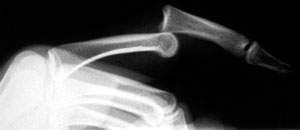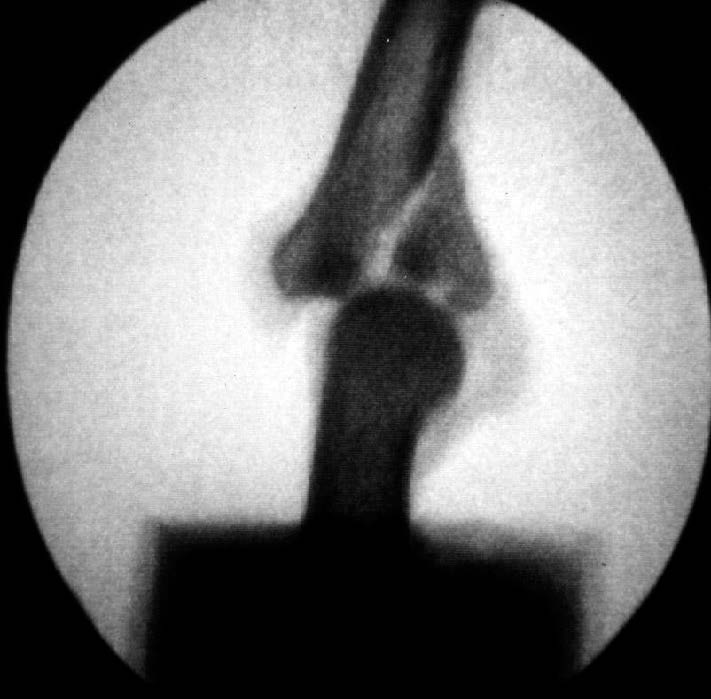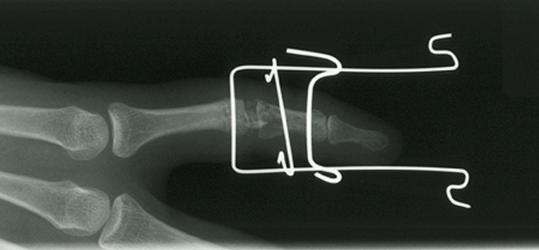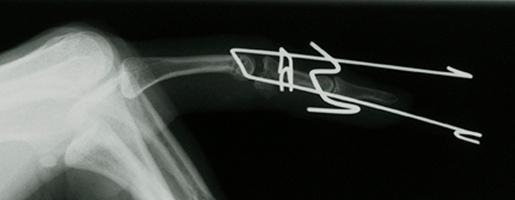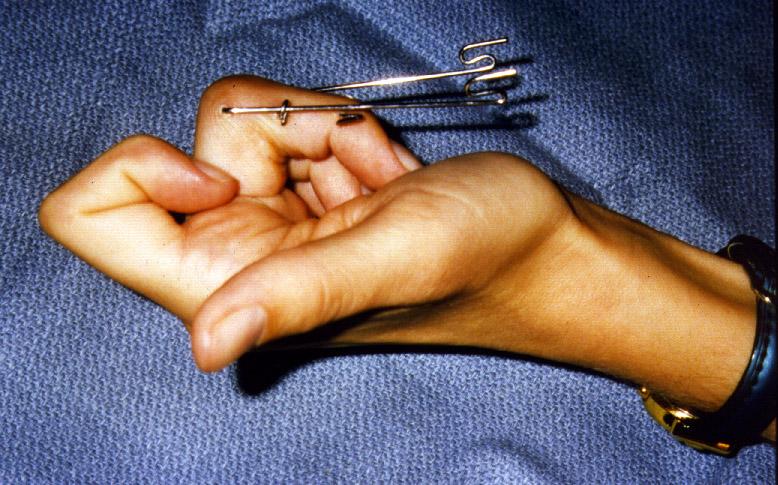
PIP Joint Injuries
The proximal interphalangeal (PIP) joint is the middle joint of the finger. It is an unforgiving joint when injured, and often becomes extremely stiff. What most people don’t realize is that the bones of the fingers heal extremely quickly, and if this joint suffers a significant fracture, they injury can become essentially irreparable within only 3 weeks. That’s a good reason to see a hand surgeon quickly following a PIP joint injury.
There are different degrees of PIP joint injury. A simple PIP joint dislocation without a fracture is almost always a stable injury once reduced (set) (Figure 26). Splinting these simple dislocations is often counterproductive, because it leads to stiffness. This stiffness can become severe enough within 3-4 weeks so that nothing short of a surgical release will allow motion to be regained. This creates the need for surgery where none might have otherwise existed. However, if motion is begun early, near-normal joint motion and full function can be often be regained, although joint thickening from scar may be permanent. Standard advice is to wait one year before resizing rings; after roughly one year the joint will assume its permanent appearance.
In those cases in which the ligament does not heal correctly, leading to persistent joint instability, the ligament can be reconstructed using a tendon graft from the forearm (see video of ligament reconstruction). This is the same tendon used for ‘Tommy John’ surgery of the elbow and does not lead to any functional problems. PIP joint collateral ligament reconstruction is an effective outpatient procedure.
However, PIP joint fracture-subluxations are treacherous injuries. A fracture-subluxation (or fracture-dislocation) means that a critical part of the joint is broken (fractured), which allows the joint to sublux, or partially dislocate (Figures 27 & 28). This injury leads to pain, stiffness and if not treated, to arthritis often within 6-12 months. Even after optimal treatment, the joint will never be fully normal. The joint may always have tenderness, may ache (especially when the weather changes) and will never regain full motion.
PIP joint fracture-subluxations are tough enough to treat early. Late treatment is even more problematic. The priorities for treatment are: 1) Reduce the joint subluxation so that the joint is located. Failure to do this essentially guarantees early arthritis, 2) Obtain joint motion. Otherwise, the joint becomes extremely stiff, 3) – And this priority is, by far, the least important of these three goals – try to reduce the fragments of the joint. Please note that this is not always possible, and that many people can do well without the joint fragments reduced, as long as the first two goals are met.
The fracture part of these injuries is often highly comminuted, meaning that it is made up of many very small fragments than cannot be reduced (put back into good position) by opening the fracture directly. Relying only on open surgery to reduce these fractures often has a high rate of stiffness, complications, and suboptimal results.
Slade dynamic external-fixators are usually kept in place for 6 weeks. And they need to be taken care of. It is extremely important to be responsible in looking after these. These require protective splints over them all the time except when bathing or performing motion exercises, to prevent them from catching on clothes, other people, or objects. The wires cannot be allowed to get snagged and bent. Extra rubber bands should always be carried in case one breaks. Follow-up X-rays are taken every week to start, then every two weeks. Hand therapy sessions must be attended and ‘homework’ performed to regain motion (Figure 31). The fixators are removed in the office, usually after 6 weeks. This does not hurt very much and is nothing to worry about.
If the PIP joint fracture-subluxation is not seen within 1-2 weeks, the Slade dynamic external fixator can often be used, but now the joint often has to be opened to clean out scar tissue and allow the joint to reduce. This creates more scar and the ultimate motion and end result are often not as good. After 4-6 weeks, the PIP joint fracture-subluxation often cannot be fixed and needs to be reconstructed (replaced).
The best reconstruction, in most cases, is a “Hemi-Hamate Arthroplasty”. The Hemi-Hamate Arthroplasty involves removing a portion of the hamate (a wrist bone) with its cartilage and using it to replace the destroyed PIP joint surface. While the Hemi-Hamate Arthroplasty probably works better than the other options for late-presenting PIP joint fracture-subluxations, the joint never regains full motion, and the results are not nearly as good as for early injuries treated by the Slade dynamic external fixator. Remember that scar has formed before the surgery, and the original joint surfaces are now destroyed. In addition, some amount of arthritis is often present by this time.
Once significant arthritis has occurred, treatment options are limited to joint replacement or fusion. Both of these are salvage options. Newer options for joint replacement work better, but are still not as good as a natural joint. Therefore, it’s best to get PIP joint injuries treated early to have the best chance of a good result.

